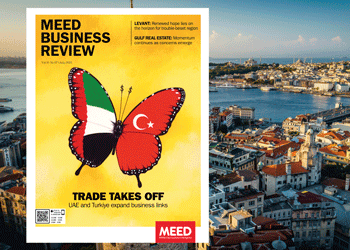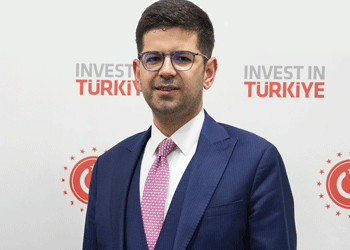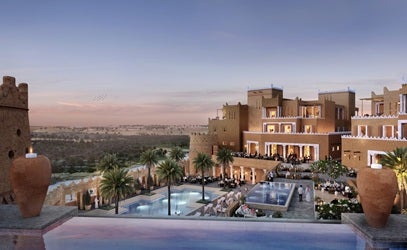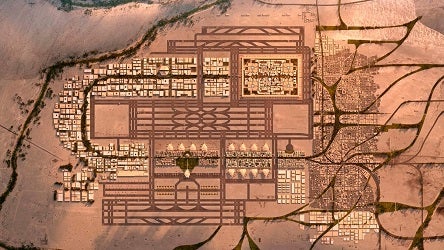Liquidity drives project finance appetite
27 October 2023

This report on project finance and PPP also includes: PPP activity rebounds in 2023
Activity in the Gulf region has triggered a boom in the project finance market, with Saudi Arabia leading the way on the back of schemes linked to its Vision 2030 strategy.
Deals are fanning out from power and water and infrastructure schemes into unexplored territory: hydrogen projects and ever-larger solar power plants have opened up opportunities for international and regional banks that are awash with liquidity and looking for long-term means to deploy it.
Deal advisers attest to the vibrancy of Saudi Arabia, the largest regional projects market with $1.2tn-worth of known work in the pipeline. The kingdom has seen the largest project financing this year, a facility worth at least $6bn arranged for the Neom green hydrogen project.
“Saudi Arabia is a market that really is firing on all cylinders,” says Rob Harker, a partner at law firm DLA Piper, which advised Neom Green Hydrogen Company in connection with its green hydrogen and ammonia project in Saudi Arabia.
“That demand is not limited to utility sector projects. In addition to the very large solar and wind projects – including a Saudi solar deal that is 1.1GW – we are also seeing a large volume of social infrastructure projects being procured across the GCC, including in education, healthcare, social accommodation and transport,” he adds.
“Bank debt – both regional and international – is still the principal source of financing for these projects. However, robustly structured projects should also be attractive, particularly on a refinancing, to a capital markets issuance.”
Robust liquidity support
There is increased liquidity in the regional banking market, notes John Dewar, partner in international law firm Milbank’s global project, energy and infrastructure practice, which advised the export credit agencies (ECAs) and commercial banks in connection with Project Lightning, Abu Dhabi National Oil Company’s offshore power transmission project.
“With the bullish medium-term oil price outlook, there is significant liquidity in the Saudi and UAE bank markets, with these banks looking to on-lend their petrodollar deposits on a longer-term basis.”
This still poses some challenges. Analysts note that despite the bountiful credit availability, things can change.
“There is still a lot of liquidity in the system in the GCC, but some have voiced concerns that liquidity in the banking market could dry up in the future if they have to compete with projects that are much larger in scale,” says Christiane Kuti, a director at Fitch Ratings.
“Overall liquidity in the market could get tight at some point, although we are not there at the moment.”
Even then, notes Kuti, a lower oil price could add impetus to the need to develop frameworks to make projects more bankable, and provide an opportunity for the capital market to play a bigger role.
Most of the larger deals are witnessing a heterodox mix of local and international banks participating. For example, a consortium of five local and international banks has agreed to provide $545m of financing for the Rabigh 4 independent water producer project in Saudi Arabia, with Standard Chartered Bank lining up alongside Bank of China and the local trio of Saudi National Bank, Riyad Bank and Saudi Investment Bank.
The Chinese bank presence is a pointer. “We have seen Chinese banks participating in project finance deals, and that is set to continue as they are not as constrained as some of the regional banks in terms of the tenor on which they can lend. Their ability to lend on a longer-term tenor is sometimes attractive for sponsors and developers,” a source tells MEED.
The flipside of this is that Chinese lenders are less knowledgeable about the market.
Global uncertainties
Despite the robust oil price climate, project financings across the Middle East and North Africa (Mena) region have had to cope with a choppy global interest rate environment, with inflationary pressures also impinging.
Higher interest rates have militated against the use of capital market instruments in some regional deals. For Abu Dhabi’s subsea transmission system deal, which reached financial close earlier this year, higher interest rates were responsible for adding $200m to the $3.8bn deal.
This has implications for other projects that are seeking refinancing on the capital market. In Saudi Arabia, BlackRock-led investors in Saudi Aramco’s gas pipeline network attempted early in 2023 to raise $4.5bn from a sale of bonds to refinance a multibillion-dollar loan. The 10-year mature sukuk (Islamic bond) tranche spread placed it about 120 basis points above where Aramco bonds maturing in October 2030 were trading, according to Reuters’ calculations.
Another consortium led by US-based energy infrastructure investment firm EIG Global Energy Partners had also looked to the bond markets to refinance.
“The EIG and BlackRock-led consortiums investing in Saudi Aramco’s oil and gas pipelines infrastructure have been looking to refinance more than $20bn of acquisition debt,” says Dewar.
“Both have been active in the bond market, but the interest rate environment has moved against bonds, so there has been an increasing focus by borrowers on accessing other longer-term liquidity sources, particularly from the highly liquid regional banks.”
Capital market instruments
For the moment, capital market instruments are largely confined to refinancing rather than greenfield projects. However, once some of these projects are financed, it could encourage others to lend on that basis.
“Once a project has been up and running, and it has got consistent revenue from the offtaker of the electricity or the water, and they are paying an index-linked revenue stream that is 100 per cent take or pay and insulated from the erosion of any inflationary pressures, that is very attractive for bondholders, pension funds and other institutions that want stable revenues,” says one industry insider.
Beyond the Gulf, Egypt has managed to attract project finance for its renewable energy schemes, with significant ECA support. In March 2023, a $690m non-recourse financing was arranged for the 500MW Gulf of Suez Wind 2 project in Egypt.
The renewable energy push has continued after Cairo’s hosting of the 2022 Conference of the Parties of the UN Framework Convention on Climate Change (Cop27). The drive has included the Amunet wind and Abydos solar projects closed by Amea Power, as well as the Gulf of Suez Wind 2 project sponsored by Engie, TTC-Eurus and Orascom.
“They are both important deals in a global context because they mark the first occasions on which the Japanese ECAs have co-financed with the International Finance Corporation and the European Bank for Reconstruction & Development, respectively, opening up important new financing opportunities in emerging markets,” says Dewar.
Support from ECAs is particularly valued in Egypt, given the economic challenges the country is facing.
A planned polypropylene complex due to be developed in Egypt’s Suez Canal Economic Zone has been put on hold, with the $1.7bn project developed by Red Sea Refining & Petrochemical Company having been affected by the depreciation of the Egyptian pound.
More regional financing
Another emerging theme will be for the larger Mena banks to play a bigger role in regional project financings.
The likes of First Abu Dhabi Bank have been active across GCC borders, including in Saudi Arabia. Given their healthy liquidity profiles, the biggest banks in the GCC are better positioned for longer-tenor project finance deals than ever before.
Not that it will be plain sailing. Structural impediments will still have to be overcome.
For example, most Saudi banks still need to get consent from the Saudi Arabian Monetary Agency (Sama) to participate in dollar loans. “That can constrain their ability to operate outside the kingdom,” says Dewar.
“There is a regulatory preference for them to make Saudi riyal loans rather than dollars. But because of the increase in dollar liquidity, there is much more availability in the Saudi market than there was a year ago.”
Project finance will remain a critical part of the funding mix in the Mena region. As Fitch Ratings notes, the significant growth needed to achieve the GCC’s investment requirements cannot be attained using traditional financing channels, such as on-balance-sheet funding by governments. Instead, there is a need to broaden the investor base, including through project financing.
The likelihood of a more benign global interest rate environment in 2024 should pave the way for a reassertion of capital market-based deals, making the next few months busy ones for banks and deal-makers across the Mena region.
Exclusive from Meed
-
 UAE and Turkiye ties deepen
UAE and Turkiye ties deepen4 July 2025
-
 Building on UAE-Turkiye trade
Building on UAE-Turkiye trade4 July 2025
-

-
 Court rules against Petrofac restructuring plans
Court rules against Petrofac restructuring plans4 July 2025
-

All of this is only 1% of what MEED.com has to offer
Subscribe now and unlock all the 153,671 articles on MEED.com
- All the latest news, data, and market intelligence across MENA at your fingerprints
- First-hand updates and inside information on projects, clients and competitors that matter to you
- 20 years' archive of information, data, and news for you to access at your convenience
- Strategize to succeed and minimise risks with timely analysis of current and future market trends

Related Articles
-
 UAE and Turkiye ties deepen
UAE and Turkiye ties deepen4 July 2025
 Commentary
Commentary
Colin Foreman
EditorRead the July issue of MEED Business Review
The growing trade volumes between the UAE and Turkiye involve a mix of competition and collaboration across various sectors.
One area of competition is aviation. Turkish Airlines has emerged as a major global player over the past 20 years, with its network now covering more countries than any other airline.
Turkiye’s aviation sector entered a new era in 2019 when Istanbul Grand airport opened. The first phase has the capacity to handle 90 million passengers a year, and the plan is for the capacity to reach 200 million once later phases are completed.
The airport’s globally strategic location combined with its large and expandable capacity will give Turkiye’s aviation
sector an edge over its competitors in the Gulf over the next decade as construction starts on major airports, including Dubai and Riyadh.While competition is evident, Turkish Airlines insists there is enough room for it and the Gulf airlines to grow as the centre of gravity for global aviation shifts from west to east.
On a macro level, the UAE and Turkiye are complementary economies
Beyond aviation, the trade relationship encompasses a wide range of sectors, including defence, logistics and construction. Over the past two years, Turkish contractors have secured significant contracts in the UAE. Turkish construction companies are now exporting the experience they have gained on projects in Turkiye to the UAE, as major government- backed infrastructure projects that include airports and railways move into tendering.
At the same time, UAE investments in Turkiye’s energy and financial sectors are growing, with notable examples including Emirates NBD’s investment in DenizBank and International Holding Company’s investment in Kalyon Energy.
These investments show that on a macro level, the UAE and Turkiye are complementary economies, with each holding a different mix of resources, capital and expertise. The strategic location of both countries amplifies the business case for trade even further.
 READ THE JULY 2025 MEED BUSINESS REVIEW – click here to view PDF
READ THE JULY 2025 MEED BUSINESS REVIEW – click here to view PDFUAE and Turkiye expand business links; Renewed hope lies on the horizon for trouble-beset Levant region; Gulf real estate momentum continues even as concerns emerge
Distributed to senior decision-makers in the region and around the world, the July 2025 edition of MEED Business Review includes:
> AGENDA: UAE-Turkiye trade gains momentum> INTERVIEW 1: Building on UAE-Turkiye trade> INTERVIEW 2: Turkiye's Kalyon goes global> INTERVIEW 3: Strengthening UAE-Turkiye financial links> INTERVIEW 4: Turkish Airlines plans further growth> CURRENT AFFAIRS: Middle East tensions could reduce gas investments> GCC REAL ESTATE: Gulf real estate faces a more nuanced reality> PROJECTS MARKET: GCC projects market collapses> INTERVIEW 5: Hassan Allam eyes role in Saudi Arabia’s transformation> INTERVIEW 6: Aseer region seeks new investments for Saudi Arabia> LEADERSHIP: Nuclear power makes a global comeback> LEVANT MARKET FOCUS: Levant states wrestle regional pressures> GULF PROJECTS INDEX: Gulf projects index continues climb> CONTRACT AWARDS: Mena contract award activity remains subdued> ECONOMIC DATA: Data drives regional projects> OPINION: A farcical tragedy that no one can endTo see previous issues of MEED Business Review, please click herehttps://image.digitalinsightresearch.in/uploads/NewsArticle/14201376/main.gif -
 Building on UAE-Turkiye trade
Building on UAE-Turkiye trade4 July 2025
 This package on UAE-Turkiye relations also includes:
This package on UAE-Turkiye relations also includes:> UAE-Turkiye trade gains momentum
> Turkiye’s Kalyon goes global
> UAE-Turkiye financial links strengthen
> Turkish Airlines plans further growth

The UAE-Turkiye Comprehensive Economic Partnership Agreement (Cepa) that came into effect in September 2023 has already exceeded expectations.
Non-oil trade between the UAE and Turkiye grew by 11.5% in 2024, reaching a total of $40.5bn. This milestone surpasses a target of the Cepa three years earlier than planned. As a result, Turkiye is now the UAE’s fourth-largest non-oil trading partner, rising from seventh place in 2021.
Trade between the UAE and Turkiye is growing strongly, with both countries increasingly viewed as strategic hubs for accessing broader markets.
The growth story builds on already established business links between the two countries.
“UAE-based companies and funds are already very active in Turkiye,” says Burak Daglioglu, president of the investment and finance office of the Presidency of the Republic of Turkiye.
“Firms like DP World and others in private equity and venture capital are playing a key role.”
Strengthening ties
 Since the Cepa was signed in 2023, bilateral investment has accelerated, with Turkish companies also expanding into the UAE.
Since the Cepa was signed in 2023, bilateral investment has accelerated, with Turkish companies also expanding into the UAE. “That’s the mark of a healthy relationship,” he says. “When it’s balanced and bilateral, it’s more sustainable.”
He adds that companies in both countries see the other not just as a market, but as a hub. “UAE firms use Turkiye to access Europe and Central Asia; Turkish firms use the UAE to reach Asia and Africa. This creates a complementary strategy for both sides.”
In the energy sector, the focus is on renewables, with UAE firms eyeing major solar and wind projects in Turkiye. “We have huge potential in renewables, and there are ongoing talks with UAE investors,” says Daglioglu.
In technology, Turkiye is emerging as a regional player in artificial intelligence (AI), financial technology (fintech), and healthcare technology.
“Our infrastructure is increasingly AI-ready,” he says. “We have data centres, renewable power sources and connectivity.
“We also have a robust startup ecosystem, with early-stage funding rising from under $100m a decade ago to over $1bn today.”
Defence is another key area of cooperation. “There are some ongoing projects in the defence sector between Turkiye and the UAE,” Daglioglu says. “It’s better not to name names at this stage, but it’s a promising area.”
Venture capital (VC) is also playing an important role in promoting regional innovation. “Ten years ago, the startup scene was nascent. Now, it’s a cornerstone of our investment strategy. Dubai, as a regional VC hub, has been instrumental.”
To support this growth, Turkiye has developed local VC legislation and attracted international funds, including those from Saudi Arabia, UAE family offices and corporate investors. A joint UAE-Turkiye technology fund worth $300m is also nearing finalisation.
“It’s not just about exits anymore. Turkish startups are scaling regionally and globally, with Dubai often serving as their capital and client gateway.”
Turkiye is also a major industrial hub and, with a population of 85 million, has extensive human resources. “We have the talent, the infrastructure and the resilience,” he says.
“From automotive and mobility to chemicals and energy storage, we are expanding our industrial base.”
We have huge potential in renewables, and there are ongoing talks with UAE investors
Looking ahead
Turkiye’s trade with the UAE and the rest of the GCC could be enhanced even further with the Development Road project, which is a 1,200-kilometre highway and railway linking Iraq’s southern Faw Port to Europe through Turkiye.
“The Development Road will not happen overnight – it’s a long-term, complex undertaking,” Daglioglu says. “But its impact will be global. Reducing shipping lead times between Asia and Europe by up to a week is hugely significant in today’s fast-moving markets.”
Designed to connect the Gulf to Europe through Turkiye, the Development Road includes a high-speed rail network for both cargo and passengers, as well as a parallel motorway.
For Daglioglu, the Development Road corridor offers Turkiye, the UAE and the GCC states another platform for economic diversification.
“This is more than a transport project, it’s a regional realignment,” he says.
“It will unlock a flow of goods, people, capital and data. Fibre infrastructure can run alongside the rail and motorway, creating a dual-purpose corridor that will support our AI and digital economy ambitions.”
Historically, Turkiye has been well integrated with northern markets in Europe. Due to years of conflict in Iraq and Syria, however, its southern connectivity has lagged.
The Development Road, along with recent discussions to reopen direct links with Syria, offers opportunities for southern expansion.
“We have invested heavily in northern logistics. Now, it’s time to strengthen our southern corridor,” Daglioglu says. “The Development Road could finally make direct access to the GCC markets a reality.”
The corridor could also open up new avenues for digital infrastructure, such as subsea cables and terrestrial fibre,
further linking the region’s digital economies.“This could be the basis for a digital Silk Road, supporting everything from AI to fintech.”
https://image.digitalinsightresearch.in/uploads/NewsArticle/14201047/main.gif -
 Firms submit Diriyah’s Radisson Red superblock prequalifications
Firms submit Diriyah’s Radisson Red superblock prequalifications4 July 2025

Register for MEED’s 14-day trial access
Saudi gigaproject developer Diriyah Company has received prequalification statements from firms interested in constructing the upcoming Radisson Red superblock in the second phase of the Diriyah Gate development (DG2).
The prequalification notice was issued on 11 June, and submissions were made on 22 June.
The Radisson Red superblock consists of a hotel, residential apartments, retail facilities, commercial office spaces and a park.
The project is situated in the Boulevard East district, between King Khalid Road and the Grand Boulevard in Diriyah.
The project is the latest in a series of other superblocks that are expected to be floated to the market this year, including the Waldorf Astoria superblock, Edition superblock and Pendry superblock.
Diriyah tendered a contract in April to build the new iconic museum in the DG2 area.
The same month, MEED exclusively reported that the client had awarded an estimated SR4bn ($1.1bn) contract for a utilities relocation package for the King Saud University (KSU) project located in DG2.
The contract was awarded to the joint venture of Beijing-headquartered China Railway Construction Corporation and China Railway Construction Group Central Plain Construction Company.
Also in April, MEED reported that the company had awarded an estimated SR5bn ($1.3bn) construction deal to build the Royal Diriyah Opera House.
The contract was awarded to a joint venture of local firm El-Seif Engineering & Contracting, Beijing-headquartered China State Construction Engineering Corporation and Qatari firm Midmac Contracting.
Tendering activity is also progressing on several other major schemes at Diriyah, including the King Khalid Road project, which passes through the development. The client received bids from firms in the second week of April for the main construction works on this project.
The client is also expected to finalise the contract award shortly for the Arena Block assets in the Boulevard Southwest section in the DG2 area.
Diriyah gigaproject
The Diriyah masterplan envisages the city as a cultural and lifestyle tourism destination. Located northwest of Riyadh’s city centre, it will cover 14 square kilometres and combine 300 years of history, culture and heritage with hospitality facilities.
The company awarded several significant contracts last year, including three contracts worth over SR21bn ($5.5bn). These included an estimated $2bn contract awarded to a joint venture of El-Seif Engineering & Contracting and China State to build the North Cultural District.
In July last year, Diriyah also awarded a $2.1bn package to a joint venture of local contractor Albawani and Qatar’s Urbacon to construct assets in the Wadi Safar district of the gigaproject.
Then in December, Diriyah Company awarded an estimated SR5.8bn ($1.5bn) contract to local firm Nesma & Partners for its Jabal Al-Qurain Avenue cultural district, located in the northern district of the Diriyah Gate project.
Once complete, Diriyah will have the capacity to accommodate 100,000 residents and visitors.
 READ THE JULY 2025 MEED BUSINESS REVIEW – click here to view PDF
READ THE JULY 2025 MEED BUSINESS REVIEW – click here to view PDFUAE and Turkiye expand business links; Renewed hope lies on the horizon for trouble-beset Levant region; Gulf real estate momentum continues even as concerns emerge
Distributed to senior decision-makers in the region and around the world, the July 2025 edition of MEED Business Review includes:
> AGENDA: UAE-Turkiye trade gains momentum> INTERVIEW 1: Building on UAE-Turkiye trade> INTERVIEW 2: Turkiye’s Kalyon goes global> INTERVIEW 3: Strengthening UAE-Turkiye financial links> INTERVIEW 4: Turkish Airlines plans further growth> CURRENT AFFAIRS: Middle East tensions could reduce gas investments> GCC REAL ESTATE: Gulf real estate faces a more nuanced reality> PROJECTS MARKET: GCC projects market collapses> INTERVIEW 5: Hassan Allam eyes role in Saudi Arabia’s transformation> INTERVIEW 6: Aseer region seeks new investments for Saudi Arabia> LEADERSHIP: Nuclear power makes a global comeback> LEVANT MARKET FOCUS: Levant states wrestle regional pressures> GULF PROJECTS INDEX: Gulf projects index continues climb> CONTRACT AWARDS: Mena contract award activity remains subdued> ECONOMIC DATA: Data drives regional projects> OPINION: A farcical tragedy that no one can endTo see previous issues of MEED Business Review, please click herehttps://image.digitalinsightresearch.in/uploads/NewsArticle/14200629/main.jpg -
 Court rules against Petrofac restructuring plans
Court rules against Petrofac restructuring plans4 July 2025
An appeals court in the UK has upheld an appeal against Petrofac’s restructuring plans, increasing uncertainty about the UK-based engineering company’s future.
The appeal was brought by Italy’s Saipem and South Korea’s Samsung E&A.
The ruling against the restructuring plans comes less than two months after Petrofac received formal approval from the High Court of England & Wales to implement its restructuring plan.
Petrofac previously said that its restructuring plan would unlock $355m in new funding for its operations.
Petrofac said on 1 July that the appeal was upheld “on narrow grounds associated with the terms of the 'new money' financing and the evidence provided in support of it”, that had previously been accepted by the High Court.
The company said that all other grounds of appeal were unsuccessful.
It added that it was “carefully studying” the detailed judgment and would discuss with key stakeholders its implications and potential routes forward.
The company’s shares were suspended from trading on the UK stock exchange at the end of April due to Petrofac’s failure to publish its 2024 financial results on time.
Wood Group, another UK-based engineering company that is active in the Middle East and North Africa region, also saw its shares suspended on the same day, for the same reason.
In January this year, Petrofac announced that it had reached a binding agreement with its creditors.
Petrofac has been struggling with financial problems since its share price collapsed in December 2023.
 READ THE JULY 2025 MEED BUSINESS REVIEW – click here to view PDF
READ THE JULY 2025 MEED BUSINESS REVIEW – click here to view PDFUAE and Turkiye expand business links; Renewed hope lies on the horizon for trouble-beset Levant region; Gulf real estate momentum continues even as concerns emerge
Distributed to senior decision-makers in the region and around the world, the July 2025 edition of MEED Business Review includes:
> AGENDA: UAE-Turkiye trade gains momentum> INTERVIEW 1: Building on UAE-Turkiye trade> INTERVIEW 2: Turkiye's Kalyon goes global> INTERVIEW 3: Strengthening UAE-Turkiye financial links> INTERVIEW 4: Turkish Airlines plans further growth> CURRENT AFFAIRS: Middle East tensions could reduce gas investments> GCC REAL ESTATE: Gulf real estate faces a more nuanced reality> PROJECTS MARKET: GCC projects market collapses> INTERVIEW 5: Hassan Allam eyes role in Saudi Arabia’s transformation> INTERVIEW 6: Aseer region seeks new investments for Saudi Arabia> LEADERSHIP: Nuclear power makes a global comeback> LEVANT MARKET FOCUS: Levant states wrestle regional pressures> GULF PROJECTS INDEX: Gulf projects index continues climb> CONTRACT AWARDS: Mena contract award activity remains subdued> ECONOMIC DATA: Data drives regional projects> OPINION: A farcical tragedy that no one can endTo see previous issues of MEED Business Review, please click herehttps://image.digitalinsightresearch.in/uploads/NewsArticle/14200679/main.jpg -
 King Salman airport sets July deadline for fourth runway bids
King Salman airport sets July deadline for fourth runway bids4 July 2025

King Salman International Airport Development Company (KSIADC) has allowed firms until 8 July to bid for the design-and-build of the fourth runway at King Salman International airport (KSIA) in Riyadh.
The tender was floated on 17 April. The previous bid submission deadline was 17 June.
It is understood that the third and fourth runways will add to the two existing runways at Riyadh’s King Khalid International airport, which will eventually become part of KSIA.
KSIADC, which is backed by Saudi Arabia’s Public Investment Fund, prequalified firms in September last year for the main engineering, procurement and construction packages; early and enabling works; specialist systems and integration; specialist systems, materials and equipment; engineering and design; professional services; health, safety, security, environment and wellbeing services; modular installation and prefabrication; local content; and environmental, social and governance and other services.
The entire scheme is divided into eight assets. These are:
- Iconic Terminal
- Terminal 6
- Private aviation terminal
- Central runway and temporary apron
- Hangars
- Landside transport
- Cargo buildings
- Real estate
In August last year, KSIADC confirmed it had signed up several architectural and design firms for the various elements of the project.
UK-based Foster+Partners will design the airport’s masterplan, including the terminals, six runways and a multi-asset real estate area.
US-based engineering firm Jacobs will provide specialist consultancy services for the masterplan and the design of the new runways.
UK-based engineering firm Mace was appointed as the project’s delivery partner, and local firm Nera was awarded the airspace design consultancy contract.
Project scale
The project covers an area of about 57 square kilometres (sq km), allowing for six parallel runways, and will include the existing terminals at King Khalid International airport. It will also include 12 sq km of airport support facilities, residential and recreational facilities, retail outlets and other logistics real estate.
If the project is completed on time in 2030, it will become the world’s largest operating airport in terms of passenger capacity, according to UK analytics firm GlobalData.
The airport aims to accommodate up to 120 million passengers by 2030 and 185 million by 2050. The goal for cargo is to process 3.5 million tonnes a year by 2050.
Saudi Arabia plans to invest $100bn in its aviation sector. Riyadh’s Saudi Aviation Strategy, announced by the General Authority of Civil Aviation (Gaca), aims to triple Saudi Arabia’s annual passenger traffic to 330 million travellers by 2030.
It also aims to increase air cargo traffic to 4.5 million tonnes and raise the country’s total air connections to more than 250 destinations.
 READ THE JULY 2025 MEED BUSINESS REVIEW – click here to view PDF
READ THE JULY 2025 MEED BUSINESS REVIEW – click here to view PDFUAE and Turkiye expand business links; Renewed hope lies on the horizon for trouble-beset Levant region; Gulf real estate momentum continues even as concerns emerge
Distributed to senior decision-makers in the region and around the world, the July 2025 edition of MEED Business Review includes:
> AGENDA: UAE-Turkiye trade gains momentum> INTERVIEW 1: Building on UAE-Turkiye trade> INTERVIEW 2: Turkiye's Kalyon goes global> INTERVIEW 3: Strengthening UAE-Turkiye financial links> INTERVIEW 4: Turkish Airlines plans further growth> CURRENT AFFAIRS: Middle East tensions could reduce gas investments> GCC REAL ESTATE: Gulf real estate faces a more nuanced reality> PROJECTS MARKET: GCC projects market collapses> INTERVIEW 5: Hassan Allam eyes role in Saudi Arabia’s transformation> INTERVIEW 6: Aseer region seeks new investments for Saudi Arabia> LEADERSHIP: Nuclear power makes a global comeback> LEVANT MARKET FOCUS: Levant states wrestle regional pressures> GULF PROJECTS INDEX: Gulf projects index continues climb> CONTRACT AWARDS: Mena contract award activity remains subdued> ECONOMIC DATA: Data drives regional projects> OPINION: A farcical tragedy that no one can endTo see previous issues of MEED Business Review, please click herehttps://image.digitalinsightresearch.in/uploads/NewsArticle/14200608/main.jpg


